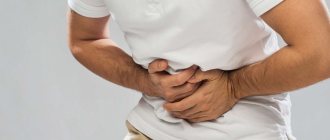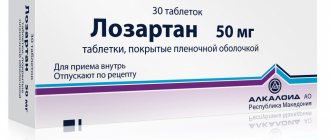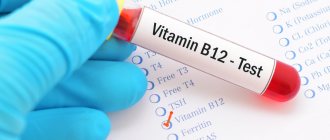October 3, 2019December 17, 2020
Vitamins and minerals are primarily involved in regulating metabolic processes in the body. Depending on age, gender, health status, weight, height, physical activity, and physiological needs, a person needs different amounts of these substances. Therefore, there are standards that help prevent vitamin deficiency and its consequences associated with the development of diseases. Prevention of vitamin D deficiency is an important public health goal. Among the vitamins valuable for a woman’s health, of course, vitamin D (calciferol) plays a special role, existing in two forms - D2 and D3, the activation of which occurs in the liver and kidneys.
Types of vitamin D - D2 and D3
D3 (cholecalciferol) is called “solar” because it is formed in the skin due to exposure to ultraviolet radiation. To do this, children and adults should spend about 15–30 minutes in the sun several times a week. However, intensive production of vitamin D occurs during hours that are harmful to health - from 11:00 to 14:00, when the skin needs protection.
In addition, the natural absorption of the vitamin decreases over time, and people with dark skin absorb it more slowly. Negative factors for the perception of beneficial sunlight are sunscreens and unfavorable ecology, such as air pollution. Therefore, even in the summer months, not always and not everyone can stock up on cholecalciferol.
D2 (ergocalciferol) enters the body along with the usual food. However, not many foods of animal origin are known to be enriched with vitamin D: fatty fish (herring, sardines, salmon, mackerel, tuna, halibut), lamb, eggs (yolk), butter, cream, sour cream, hard cheese, beef liver , seafood, cod liver, red caviar, fish oil. The vitamin is present in limited quantities in plant foods: chanterelle mushrooms, oatmeal, potatoes, oranges, parsley, broccoli, nuts, vegetable oils.
It is important to follow the cooking rules so that the beneficial vitamin is not destroyed. It has also been proven that food cannot provide the body with a sufficient dose of D2, since this requires eating too many foods rich in it, some of which also contain cholesterol. In addition, this list contains things that are advised to be consumed with caution or are not allowed at all for pregnant women and in the first 6 months of lactation.
VITAMIN D DEFICIENCY: SYMPTOMS, CONSEQUENCES, TREATMENT
The statistics are not encouraging: about 90% of people around the world are deficient in vitamin D. Doctors around the world take this vitamin deficiency seriously. And vitamin D preparations are undeniable helpers in this matter.
Vitamin D has been researched for over 100 years. Initially, the effect of this vitamin on the condition of the skeleton (the so-called bone function) was considered, but in the last 30 years the attention of scientists has been focused on the extraosseous functions of vitamin D. Let's first look at its classical indications.
Classic properties of vitamin D:
- Healthy bones and muscles. Vitamin D plays an important role in the absorption of calcium: it regulates calcium-phosphorus metabolism in the body, promotes growth, strengthening the skeleton, and proper mineralization of bone tissue. Therefore, for growth and proper development, doctors often prescribe vitamin D supplementation even for newborn children and adolescents during the period of active growth, in order to avoid improper bone development (rickets). In adulthood and old age, a lack of vitamin D can lead to softening of the bones (osteomalacia), and deficiency increases the risk of developing osteoporosis and fractures.
- Health and beauty of teeth. Without vitamin D, the formation of teeth is disrupted, they will be more fragile, and thinning of the enamel is provoked. Tooth decay develops more often in those who have a vitamin D deficiency.
In addition to the classical indications that we have known since childhood, vitamin D also has a lot of other properties, which doctors call neoclassical or extraosseous effects of vitamin D
Neoclassical indications for vitamin D:
- Immune activation: Reduces the risk of developing colds, flu, and autoimmune diseases. Tip: If you are tired of frequent colds, it makes sense to start taking vitamin D.
- Increases performance, concentration, memory and learning ability. Scientists have found that people with lower levels of vitamin D perform worse on exams, have more difficulty making decisions, and have difficulty completing tasks that require attention and concentration.
- Controlling blood sugar and preventing diabetes. Diabetes mellitus occurs due to the lack of insulin or insufficient secretion of insulin. Since calcium is necessary for the production of insulin, vitamin D helps maintain the secretion of this hormone.
- Cancer protection. Vitamin D deficiency is particularly associated with increased risks of breast, colon and prostate cancer.
- Helps fight cardiovascular diseases. Because this vitamin is involved in regulating blood pressure, cholesterol levels and inflammation.
- Helps regulate hormones and improve mood. Low vitamin D levels can also interfere with the proper production of testosterone and estrogen.
Who is at risk:
- People over 45 years old. With age, a person's metabolism slows down, which interferes with the independent synthesis of vitamin D from the sun and food.
- People with dark skin. Nature intended that dark skin blocks the synthesis of vitamin D. According to research, 90% of people with dark skin pigmentation suffer from a lack of vitamin D.
- People using creams with SPF protection. Almost all face and body creams contain SPF protection, which blocks the synthesis of vitamin D. The widespread and widespread use of UV protectors, even in northern countries, contributes to the development of vitamin D deficiency in the world. For example, using SPF 8 sunscreen reduces the body's ability to produce vitamin D by 90%. And the more common and doctor-recommended sunscreen with SPF 30 reduces this ability to 99%.
- Obesity and excess weight block vitamin D synthesis.
- A sedentary lifestyle puts most nutrients into a dormant state, incl. and vitamin D, and also slows down metabolism, which interferes with the independent synthesis of vitamin D from the sun and food.
- The predominance of plant foods in the human diet (excluding milk, liver, fatty fish and eggs) reduces the intake of vitamin D in the body.
- People of large industrial cities. The level of pollution in most large Russian cities is off the charts: industrial emissions and dust do not transmit the required spectrum of UV rays necessary for the synthesis of vitamin D.
Symptoms of Vitamin D Deficiency
A blood test will help you find out for sure whether you have a vitamin D deficiency. However, there are a number of symptoms indicating its deficiency:
- You feel constantly tired and lack of strength
- You suffer from frequent colds
- You are worried about absent-mindedness and inability to concentrate
- You regularly notice yourself in a bad mood for no apparent reason
- You are concerned about the deterioration of your hair, nails and skin
- Experiencing muscle fatigue or pain in bones and muscles
- Began to notice sweating of the scalp
If any of these concerns you, there is reason to wonder if you may already be developing a vitamin D deficiency.
What is vitamin D3?
Vitamin D3 (cholecalciferol) is a vital fat-soluble vitamin necessary to ensure the functioning of almost all organs and systems of the human body. It exists in a free form in nature, unlike other metabolites of vitamin D. Vitamin D3 is formed in human skin under the influence of sunlight. Compared to vitamin D2, it is characterized by 25% higher activity.
How does the sun help us produce vitamin D3?
Our bodies convert sunlight into chemicals that then become vitamin D3. Cholesterol in the skin converts "previtamin D" into the beneficial vitamin D3, which is sometimes also called provitamin D. Previtamin D first passes through the kidneys and liver through the bloodstream and is then converted into the biologically active compound calcitriol. To get the required amount of sun to produce the vitamin, you need to sunbathe every day for about an hour and at least 60% of the skin should be exposed. If there are few sunny days in your region, it is better not to get carried away with the solarium, since, according to doctors, regular exposure to such sources of UV radiation is even more dangerous in terms of cancer than solar UV radiation, because the skin of a white person is no longer sufficiently pigmented, to protect us from cancer. Therefore, most scientists rightly noted, do we want to expose our skin to such an amount of UV radiation, causing the risk of cancer?
Statistics show that modern people in urban environments are not able to spend enough time in the sun every day for the synthesis of vitamin D.
How to get vitamin D from food?
Known leading foods in terms of vitamin D content are fatty fish: tuna, mackerel, sardine, cod liver, catfish.
But there is an important nuance that affects the vitamin D content in these products. It turns out that vitamin D is lost during heat treatment. The modern food industry is not able to ensure the delivery of freshly caught fish to your table, since the duration of any logistics is forced to subject fresh products to deep freezing in order to deliver such fish catches to processing plants (for example, for the production of canned fish or cod liver) or to stores. In addition, we heat treat (cook hot food, to put it simply) any fish, thereby significantly reducing the vitamin D content in food.
Unfortunately, the listed products are frozen and then heat-treated, due to which vitamin D is lost in them. Moreover, these products are high in calories, for example, 100 g of a regular chocolate bar contains 535 kcal, and 100 g of cod liver contains 613 kcal. Therefore, if you set a goal and consume vitamin D through food, it can lead to obesity. While some foods provide vitamin D and should be included in your daily diet, exposure to sunlight is still the best way to get vitamin D.
The consequences of a lack of vitamin B are many.
Here are just a few of the most common:
- weak immunity
- chronic fatigue
- depression
- problems with conception
- aging skin, deterioration of nails, hair
- diseases of bones and muscles and others.
Unfortunately, it is quite problematic for modern people to replenish the daily requirement of vitamin D on their own, and the consequences of deficiency can lead to serious consequences. This is why doctors increasingly recommend compensating and treating vitamin D deficiency with pharmaceutical forms of vitamin D.
BENEFICIAL PROPERTIES OF VITAMIN D
Vitamin D or the “sunshine vitamin” is an essential nutrient that is involved in all processes in our body. That is why it is rightfully called a unique “substance of the 21st century”
Source of the article: https://detrimax.ru/
BIOLOGICALLY ACTIVE SUPPLEMENT. NOT A MEDICINE
Sources of Vitamin D
Vitamin D was discovered about 100 years ago during the search for foods needed to combat deficiencies in calcium and phosphorus in bones and teeth. The benefits of taking fish oil, which contains large amounts of vitamin A, have been proven. However, when this vitamin was neutralized, fish oil retained its properties, which led researchers to the conclusion that it also contains other vital substances. Subsequently, the discovered vitamin received the name of the fourth letter of the Latin alphabet - D. But fish in sufficient quantities was not available everywhere, and organizing the industrial production of fish oil took time. Therefore, the research continued. It was soon discovered that the beneficial properties of certain types of food are enhanced by irradiation with ultraviolet rays. Further, it was possible to prove that vitamin D can be synthesized by living cells under the influence of sunlight.
The second wave of vitamin D research began in the 1980s. Nowadays, experts primarily name fatty fish and dairy products, as well as animal by-products as its food sources [1].
| Food | Vitamin D3 content, IU/100g |
| Cod liver | 5000–8000 |
| Herring | 294–1678 |
| Butter | 52 |
| Egg yolk | 20 ME in 1 piece. |
| Sour cream | 50 |
| Cheese | 44 |
| Beef liver | 15–45 |
If you are intolerant to the protein contained in cow's milk, dairy products made from goat's milk can be a source of vitamin D. They are especially indicated for women during pregnancy and breastfeeding [2]. Quiz: Find out how much vitamin D you get from food.
In adults
For many years it was believed that only children needed vitamin D for the correct functioning of all body systems. Studies have shown that under its influence, calcium enters the bones, promoting their proper formation and development, excluding the appearance of rickets. As for the mature age group, it was believed that there could be no deficiency of the element in men and women over 18 years of age, since the body is sufficiently exposed to sunlight. Further research in this area proved the opposite. In adults, the micronutrient controls cell division, has an anti-inflammatory effect, stimulates the activity of the immune system and promotes the production of antibacterial particles in the body, ensures optimal functioning of the nervous system, and causes the production of “antidepressive” mediators - dopamine and serotonin. When there is a shortage of it, the following occurs:
- brittle bones;
- muscle weakness, periodic cramps;
- frequent colds;
- lack of mood;
- irritability and depression;
- loose teeth, frequent caries;
- loss of appetite.
The benefits of vitamin D and why you need it
Calciferol is considered a women's health vitamin. Indeed, it is important for women. After all, its consumption, like other vitamins in general, is much higher than in the body of men. This is due to the characteristics of the female body and its functions: the menstrual cycle, pregnancy, childbirth, breastfeeding, menopause. Therefore, at different periods of life, the need for D3 and D2 may increase. But the main thing is that women need to maintain an adequate amount of calciferol, avoiding its shortage or excess.
Thus, vitamin D is essential because it:
- Responsible for the level in the blood of minerals such as calcium and phosphorus, which contribute to the preservation and strengthening of musculoskeletal tissue (bones, joints, muscles, teeth).
- Important for the musculoskeletal system, including correct posture, which is formed before the age of 20.
- Controls the functioning of the immune, cardiovascular, endocrine, hormonal, and nervous systems. In particular, it supports the level of innate immunity; acts as a hormone (D-hormone) that regulates carbohydrate metabolism, that is, it is directly related to weight loss issues. This means it is needed for proper metabolism and maintaining optimal body weight.
- Regulates more than 200 genes.
- It has anti-inflammatory, antitumor, immunomodulatory effectiveness, slows down the aging process, and fills with energy.
- Promotes conception, maintenance of pregnancy and normal gestation; it is extremely necessary during pregnancy, as it affects the formation of the immunity of the fetus and its bone tissue.
- Restores a woman’s body after childbirth, corrects the condition of PMS.
- Good for vision, concentration and memory.
Who is prescribed
Taking vitamin D during pregnancy is recommended only in special cases; usually, a balanced diet is enough. It is usually prescribed to older people, often women, as a therapy for osteoporosis, or more precisely, for the prevention of osteoporotic fractures.
However, a meta-analysis of studies of this practice in nursing homes showed that many years of eating tablets with calcium and vitamin D does not prevent fractures, but on the contrary, it increases the incidence of heart attacks. Patients with osteoporosis rather lack elastic cartilage tissue on which calcium can settle and accumulate. When cartilage is worn away, this microelement only strengthens the bones, which become not only hard, but also fragile.
“Until the end of the twentieth century, vitamin D was used only in the treatment of rickets and osteoporosis,” recalls Vasily Vlasov. — Partly because we don’t know how to effectively treat osteoporosis with anything. Observations have proven that the number of fractures in older people does not decrease. If there is no real, vital need for vitamin D, no amount of it will improve your health. This situation is similar to the widespread use of multivitamins that has become fashionable. They are taken not for medical reasons, but for prevention, often without the participation of a doctor. Dosages, as in the case of vitamin D, are much lower than therapeutic ones. And the positive effect has also not been proven. But the market share is estimated in billions of dollars.”
Many developed countries solve the problem of vitamin D deficiency by enriching mass-market food products with it: milk, yoghurts and even wheat flour. In the USA and Canada, this began to be practiced back in the 1950s, and for a long time this requirement for manufacturers was in the nature of a legislative requirement. Similar programs are popular in Western European countries. In the UK, for example, it is predicted that adding 100 mcg of the vitamin (4000 IU) to 1 kg of flour will reduce the proportion of people with insufficient vitamin D intake from 93% to 50% over a short period of time.
Lack of vitamin D in a woman’s body
Vitamin D deficiency affects 75% of the world's population, the majority of whom are women and children. The reasons why a woman’s body lacks this substance may be:
- insufficient production of D2 under sun exposure;
- winter-spring period of the year (from October to March);
- mono-diets, protein diets, unbalanced nutrition, vegetarianism, pregnancy;
- breastfeeding: in the first 6 months of breastfeeding, a woman’s vitamin D level drops sharply, which provokes a loss of calcium 4 times more than during pregnancy;
- mature age (after 50 years);
- the presence of diseases of the liver and kidneys, gall bladder, small intestine;
- excess weight;
- lack of physical activity;
- taking antacids (reducing high levels of acidity in the stomach) and anti-cholesterol drugs;
- chronic diseases of the endocrine system, gall bladder, pancreatitis, etc.
Summarize
To maintain the optimal amount of vitamin D in the body, children over one year old need to receive 600 IU per day, and adults – 800 IU. Those who are at risk are recommended to exercise daily, walk during the day (at least 20 minutes), a balanced diet, including foods that contain vitamin D. It is also necessary to maintain a normal weight and monitor the functioning of all body systems , paying special attention to the intestines, liver and kidneys. If osteoporosis is detected in your immediate family or hypovitaminosis D is diagnosed, consult a doctor immediately.
Multidisciplinary medical service means high-precision diagnostics, consultations with the best doctors, prompt and effective treatment of various diseases. Here you can undergo a full course of examination and receive help from highly qualified specialists. To make an appointment and for other questions, please call.
Date of publication: 09.24.2020 16:18:28
Learn more about vitamin D deficiency
The consequences of this condition lead to serious problems - the development of various pathologies of organs and systems. Main problems:
- immunity suffers;
- there is a metabolic disorder;
- malfunctions may occur in the functioning of organs such as the thyroid, parathyroid, pancreas, adrenal glands, kidneys, lungs, heart, intestines, stomach, pituitary gland, hypothalamus, etc.;
- possible complications during pregnancy;
- menstrual irregularities may occur;
- changes begin in bone tissue, which leads to osteomalacia (leaching of minerals from the bones), and then to osteoporosis, which is fraught with fractures and injuries;
- deformation of posture, weakness and muscle pain occurs;
- problems with the ovaries and uterus (endometriosis, fibroids, etc.);
- a hormonal imbalance occurs: the production of testosterone and estrogen may increase, which leads to early menopause;
- the condition of the skin deteriorates (vitamin D is involved in the process of renewal of skin cells), hair, teeth (caries), manifestations of skin diseases may occur;
- excess weight gain occurs;
- there is a feeling of anxiety, insomnia, depression;
- chronic fatigue and headaches are felt;
- hypertension, diabetes, arthritis, multiple sclerosis may occur;
- ARVI and acute respiratory infections become frequent.
Test: Check if you are at risk of vitamin D deficiency.
Main symptoms
Calciferol deficiency can be identified based on the following symptoms:
- Reduced processing of calcium, magnesium and phosphorus leads to the formation of cramps, muscle pain, and aching bones. The intensity of manifestations depends on the individual characteristics of the organism.
- Due to impaired calcium metabolism in the body, bones become more brittle and brittle, which causes frequent fractures.
- Decreased immunity creates susceptibility to viral infections leading to complications. The respiratory tract is especially vulnerable, damage to which can lead to bronchitis and pneumonia.
- The human body can accumulate sodium salts, the excess of which increases blood pressure. Calciferol actively counteracts this and its deficiency threatens arterial hypertension.
- With a deficiency of the vitamin, belching, bloating, diarrhea and other disruptions in the gastrointestinal tract are observed.
- The work of the sweat glands in the back of the head increases.
- Body weight increases.
- A lack of vitamin affects healthy sleep; the patient experiences insomnia at night and, as a result, lethargy and low performance during the day.
- Nervous system disorders are possible, mood swings and depression are observed. This occurs due to a disruption in the production of serotonin.
- Malfunctions of the cardiovascular system: rapid heartbeat, pain, changes in rhythm.
- Symptoms also include hair loss and bleeding gums.
A general blood test for vitamin D deficiency will show anemia, low levels of phosphorus, calcium and magnesium, and a high alkaline content.
Excess vitamin D for women
During pregnancy or with the onset of menopause, women begin to take vitamin complexes, synthesized D3 in the form of dietary supplements and medications. However, it is worth knowing that it is fat-soluble and is difficult to eliminate from the body. Due to prolonged overdose of more than 10,000 IU over many days, vitamin D easily reaches the point of toxicity. So its elevated level is also very dangerous. Hypersensitivity to this substance can also provoke an overabundance. Interestingly, the sun usually does not cause an oversaturation of the body with vitamin D.
There are two stages to the problem of hypervitaminosis. Initially, the consequences of intoxication include symptoms such as nausea, thirst, headaches, lack of appetite, weight loss, constipation or diarrhea, frequent urination, dehydration, weakness, fever, cramps, irritability, muscle and joint pain. Then calcium deposits occur in soft tissues, and atherosclerosis may develop. Severe cases include loss of consciousness and coma.
It is worth mentioning that an increased level of calciferol is fraught with infertility and the onset of early menopause, frequent colds, arrhythmia, hypertension, and liver enlargement.
Therefore, the dosage of the vitamin should be prescribed by a doctor after receiving the results of a blood test. In case of long-term use, regular testing is necessary.
Diagnostics
Patient complaints and medical examination are the basis for choosing diagnostic methods. Doctors study symptoms and laboratory diagnostic data, which can be used to judge the body’s supply of vitamins. If necessary, an instrumental examination is prescribed.
As part of the diagnosis, it is important to evaluate the parameters of phosphorus-calcium metabolism, in particular:
- calcium content;
- ionized calcium content;
- phosphorus content.
The specialist’s field of view is the level of parathyroid hormone in the blood, creatinine, calcium in daily urine.
Instrumental methods (ultrasound) determine fragments of ossification in the hip and shoulder joints, and changes in the structure of the tubular bones.
X-ray examination and (or) computed tomography is prescribed to determine skeletal abnormalities, identify signs of osteopenia, osteoporosis, deformation changes in the pelvis, and the presence of vertebral fractures. CT allows you to detect pathologically altered areas and fractures in the spine (thoracic and lumbar), in the femoral neck, and radial bones.
How to find out your vitamin D level?
You can get information about how saturated your body is with vitamin D by doing a blood test. Typically, this laboratory test is carried out if osteoporosis is suspected, during pregnancy, if the woman spends very little time in the sun, lives in the northern regions, has refused food of animal origin, has chronic diseases or hereditary disorders of the metabolism of this vitamin.
Vitamin D correction
Taking D3 is the prevention of diseases, treatment of pathologies of internal organs, a recipe for good health and longevity. However, its absorption directly depends on physical activity, for example, fitness classes, walking. Interestingly, swimming does not produce vitamin D, since water reduces body weight, relieving stress on it. Vitamin D can only be prescribed by a doctor: his recommendations must be strictly followed. The maximum dose for adult women, as well as pregnant and breastfeeding women, is 4,000 IU per day (100 mg). At the same time, women should pay attention to calcium, magnesium, vitamins A, C, E, B6, which improve the absorption of vitamin D, zinc, phosphorus, and calcium. That is why a vitamin complex is often prescribed for preventive purposes. A nursing young mother or postmenopausal woman can drink special complexes.
The combination of vitamins D2 and D3 has the most lasting effect. Vitamin D2 can accumulate in adipose tissue, forming a valuable reserve for the body. Vitamin D3 is used in metabolic processes faster, ensuring ongoing metabolism. One tablet of NUTRILITE Vitamin D combination product contains 15 mcg of vitamin D2+D3 from natural sources.
One of the popular dietary supplements is NUTRILITE™ calcium, magnesium, vitamin D, which contains the daily requirement of vitamin D. It is recommended to take 1 tablet 3 times a day with meals for a month. It is convenient to purchase and arrange delivery in Moscow or other cities of the country on the official Amway website. When taking such complexes or vitamin D on its own, you should avoid iron, which impairs its absorption. To achieve a more vivid effect and give the body everything it needs, you need to make changes to your diet. In addition, it should be remembered that the absorption of vitamin D is greatly harmed by drinking alcohol and smoking.
Children and the “sunshine” vitamin
The history of the discovery of vitamin D, which occurred about a century ago, was connected precisely with the search for a treatment for childhood rickets. It was found that this disease is a sign of calciferol deficiency. The level of this substance begins to affect the child in the womb, then during breastfeeding. Therefore, prevention of calciferol deficiency in pregnant and lactating mothers is so necessary. A deficiency can result in significant problems that are associated with the formation of the skeletal system and the baby’s susceptibility to diseases after birth, which often manifests itself after some time, including in adulthood. There is also a risk of having low birth weight babies. Prematurity, untimely cessation of breastfeeding, lack of sun, and poor nutrition deprive the baby of the necessary vitamin. But it is necessary not only to increase bone strength, growth, but also general development: vitamin D interacts with the level of cognitive potential and affects a child’s performance at school. Learn more about the symptoms of vitamin D deficiency in children.










